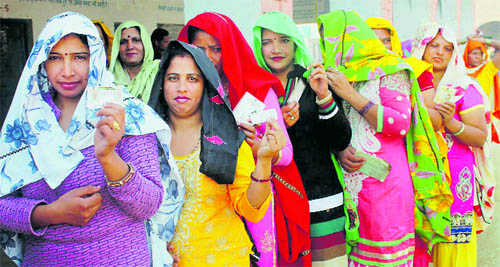
Voters at the fifth General Panchayat Election in Haryana. There are more expectations from educated representatives of panchayati raj institutions. tribune photo
S.S. Sangwan
In Haryana, the fifth General Panchayat Election (GPE) was conducted in January 2016 after the qualification of education and four other conditions on the candidates were upheld by the Supreme Court on December 10, 2015. As per educational condition, a candidates will be disqualified who “Has not passed matriculation examination or its equivalent examination from any recognized institution/board: Provided that in case of a woman candidate or a candidate belonging to Scheduled Caste, the minimum qualification shall be middle pass: Provided further that in case of a woman candidate belonging to Scheduled Caste contesting election for the post of Panch, the minimum qualification shall be 5th pass”. The candidates should have no arrears of loans from cooperatives and bills of electricity as well as declare having a functional toilet at place of residence.
The table shows that percentage of elected women is about 42,41,42 and 44 per cent in panches, sarpanches, block samiti members(BSMs) and zila parisad members (ZPMs), as against 33 per cent reserved seats for women. The overall representation of women in all post of PRIs is about 42 per cent, as compared to 36 per cent in the fourth . This quantum jump of about 17 per cent in the share of women has accorded a place of honour to women and the state often in the news for suppression suppression for women. Perhaps, the conditions of clearing arrears were more favourable to women who rarely have outstanding loans and bills in their names. As per tentative estimates, cooperative banks recovered about Rs 200 crore of overdue loans.
The representation of Scheduled Castes for panches, sarpanches, BSMs and ZPMs is about 26, 23, 26 and 23 per cent, respectively, against their average population of 20 per cent in Haryana as per 2011 Census. The SC representation in 2016 elections is about 1 to 3 per cent points (13 per cent) higher than that in 2010 GPE, except in zila parishads. where there is decrease of one per cent . This is compensated in block samitis with the increase of 3 per cent. Overall, the inclusiveness of SCs shows an increase with imposition of qualifications. The representation of other backward classes (OBCs) is 35, 26 and 18 per cent in panches, BSM and ZPM in 2016 as compared to 20, 13 and 14 per cent in the 2010 election.
For the post of sarpanches, their share is 27 per cent which is not available for 2010. It has also been reported that this time more persons from non-political families have been elected because of the conditions. This is an indication of empowerment of the weaker sections, especially the SCs and OBCs in the state.
There is a sea change in education levels, with no illiterate in this election, as compared to the previous one. Then, 32 per cent panches, 16 per cent sarpanches, 18 per cent BSMs and 8 per cent ZPMs were illiterate. Tenth and 12th pass candidates shows a quantum increase of 46, 23, 36 and 25 percentage points in panches, sarpanches, BSMs and ZPMs, as against the 2010 election. As accepted by the Supreme Court, educated representatives may be more development-oriented and improve the quality of education in government schools. They may also mobilise the support of educated and well-placed persons in their villages.
The number of unanimous elected candidates has increased 39 per cent to 56 per cent this year, as per the latest data on the State Election Commission website. It might be attributed to lack of qualified candidates but indirectly, it is a step towards social harmony. The state government is awarding Rs11 lakh to a unanimously elected panchayat. Despite the conditions, the voting percentage is quite high at 82, 85 and 87 per cent in the first, second and third phases of 2016. It is comparable to 85.8 per cent in 2010 and 82 per cent in 2005. It indicates greater participation of rural voters in the democratic process. That the election was largely peaceful validates the imposition of the conditions.
Participation of youth has increased as reflected by the average age of the elected PRI representatives. The average age will be 34, 36, 34 and 35 years of panches, sarpanches, BSMs and ZPMs, respectively. In the fourth election, only 58, 50, 62 and 62 per cent of panches, sarpanches, BSMs and ZPMs were below 40. The average age of all may be 50 years or more in 2010 elections. The average age of women representatives in the 2016 elections is 31, 33, 31 and 32 years for panches, sarpanches, BSMs and ZPMs, comparatively less than the males. Such women need to be trained for effective participation to boost to women empowerment programmes like self-help groups.
As many as 1,905 seats were left vacant due to the non-availability of qualified candidates as per the conditions. Out of these, 1,898 seats are at level of panches and the number is not as alarming as was being highlighted in the media before the elections. The state government may conduct a survey to find out the reasons and fill up these vacant PRI positions.
The numbers of elected women, SCs. OBCs, educated and youth have clearly risen. This may be taken as a broad indicator of social acceptance of education and other conditions. The issues that have been raised are: The capabilities of youth and especially women have to be improved by training them to deal with people and the functioning of panchayats. At the gram panchayat level, a sarpanch is burdened with all powers and responsibilities and the role of panches is negligible. Educated panches, even up to the graduation level, can be involved in decentralisation. Due to increased expectations of villagers from educated representatives, more funds would have to be provided by the Centre and the state government.
The writer is Professor SBI Chair, CRRID, Chandigarh.



























